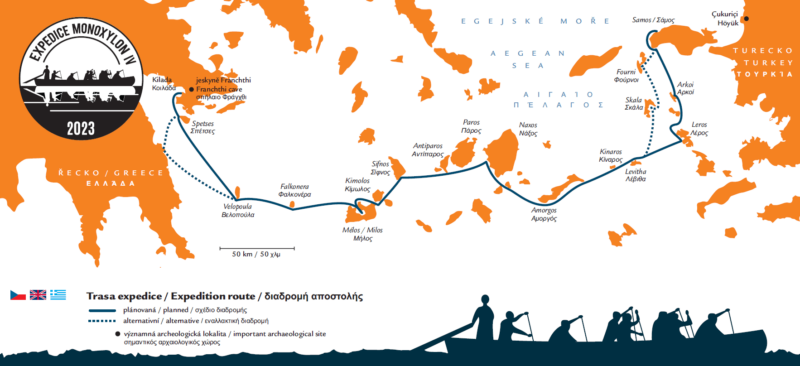Tohle je velká paráda, moc líbí.
Jako kluk jsem hltal příběhy Thor Heyerdahla, nejznámějšího experimentátora v oblasti archeologie a antropologie. Pan Heyerdahl byl ovšem poměrně odvážnější.
Díky za článek a fotografie, tohle je můj šálek kávy.
Naval Expedition Monoxylon IV.
Categories: Expeditions

On June 19, 2023, a new, fourth Monoxylon event began, i.e. the maritime expedition of doc. PhDr. Radomír Tichý, Ph.D. from the University of Hradec Králové, founder of the archaeopark in Všestary. The aim was to experimentally navigate the maritime migration route from the Middle East to Europe, through which agriculture could have spread to us 9,000 years ago. The purpose of these expeditions is to practically verify the different technologies of monoxyl production and their properties during maritime navigation. In the form of an archaeological experiment, they test monoxyl as a type of vessel that may have been used in the spread of early agricultural populations in the Mediterranean 9,000 years ago.
History of the event
The first expedition took place in 1995 and was rather experimental. At that time, there were no known finds of wooden ships from the Mediterranean region, and so the form of the monoxylon was rather hypothetical. The 231 km long route crossed the Aegean Sea, starting on the island of Samos and ending on the peninsula of Attica, near the town of Nea Makri.
The Monoxylon II event took place in 1998. The main objective was to try practically sailing a monoxylon in the Mediterranean Sea along the coasts of Italy, France, ŠSpain and Portugal , in areas proven to have been settled by the Cardium-Impresso culture during the Early Neolithic period. The total length of the route was an incredible 760 km. This event became an official part of the EXPO 98 programme with the theme 'Oceans, a heritage for the future' in Lisbon.
After more than 20 years, the Monoxylon III maritime expedition continued in 2019. The objective was to realize a voyage from the Greek mainland to the island of Mélos and to compare the performance of reed and oak monoxylon en route for the Mélos obsidian.
Monoxylon IV
For this year's expedition, a new monoxylon was used, hollowed out from the trunk of a nearly 300 year old oak tree uprooted in a storm from the Mochov forest preserve near Opočno. The dimensions and characteristics of the uprooted tree finally allowed to create a faithful replica of the Neolithic boat found at the archaeological site of La Marmotta in Lake Bracciano, Italy.
By working the 14-tonne log, after 1000 hours of work, a vessel called "King of Mochov" was created, with a length ofwith a length of 11.5m, a width of 1.2m and a dry weight of 2.8 tonnes, capable of carrying a crew of 21. One third of the ship's production was carried out using period stone tools and the rest, to save time, with modern tools.
The christening and the first successful test cruise on the Rozkoš reservoir took place in September 2022. Here the vessel reached an average speed of 5 km/h without the use of a sail, and for a short time, with the maximum effort of all 20 paddlers, it managed to reach a speed of up to 7.5 km/h.
Naostro was launched on 19 June 2023 at 10:30 on the island of Samos. The 550 km long route, passing through the islands of Fourni, Patmos, Levitha, Kinaros, Amorgos, Keros, Naxos, Paros, Despotiko, Sifnos, Milos, Antimilos, Falkonera, Velopoula and Spetses to the beachThe crew reached their planned destination on the Greek mainland in less than a month, after more than 102 hours of paddling. The expedition arrived at the final cave of Franchthi near the town of Kilada on the Peloponnese peninsula at 14:09 on 12 July 2023.
A short video showing how a raw log became a boat
You can see the full progress of the expedition, including distance travelled and timings, here: Expedition map
Finally, a small taster from the upcoming documentary and the project's Facebook page:
Zdroje: https://www.monoxylon.cz/, https://www.facebook.com/archeoparkvsestary/photos/pb.100063672758594.-2207520000/5909789765716530/?type=3&locale=ar_AR
Daniel David

The log from which the vessel was made

Working the log with stone axes

Breaking the wooden slab out of the bottom of the boat using wooden wedges

The King of Mochov on a test cruise on the Rozkosh

Expedition team
The article is included in categories:
Post
Tohle nemá chybu 👍
Brumlo, byls také členem expedice?  Pan docent je úžasnej člověk a odborník
Pan docent je úžasnej člověk a odborník 
Členem expedice jsem nebyl, ale jako student se pravidelně účastním jeho přednášek o pravěku.










